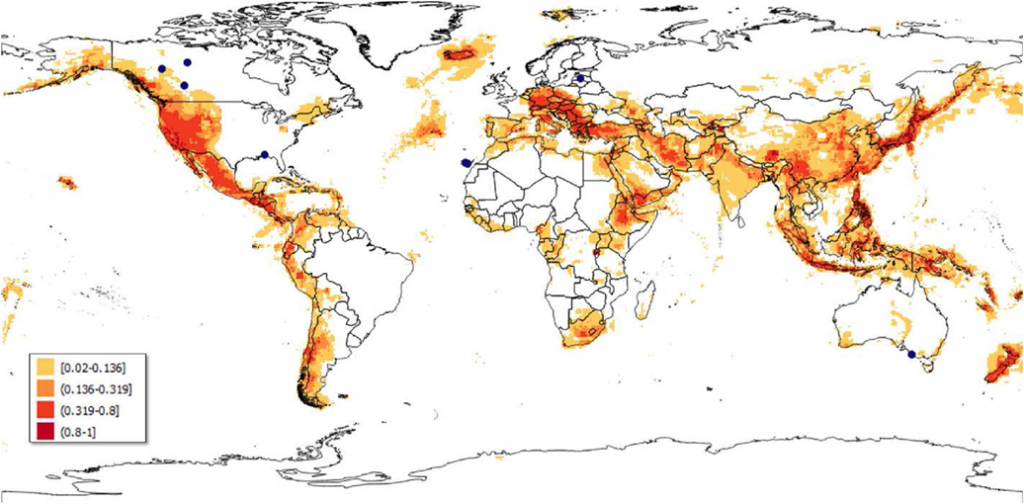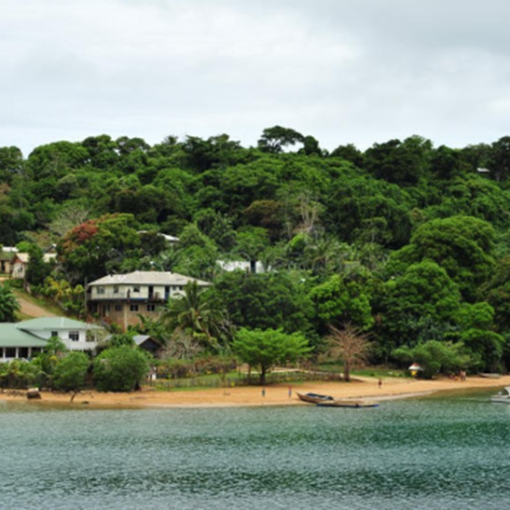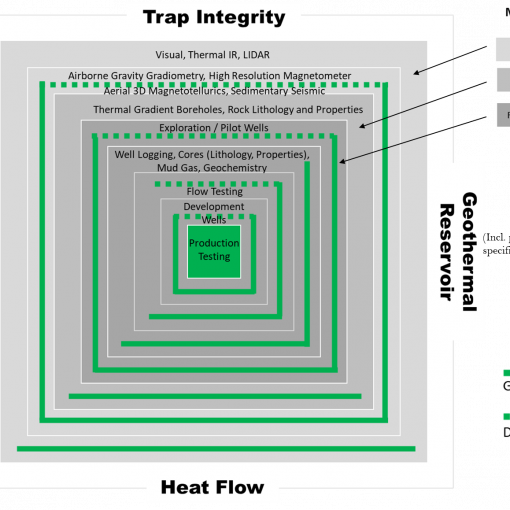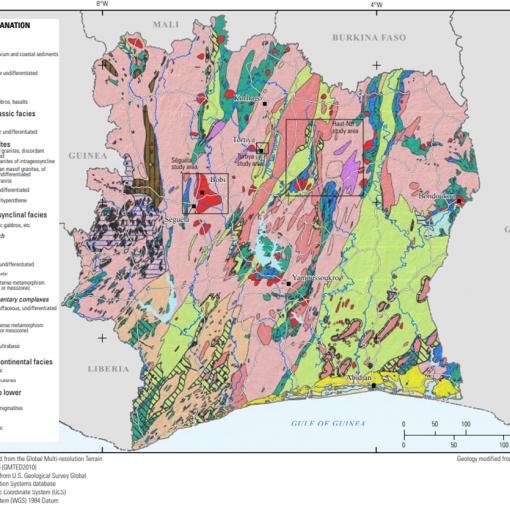Geothermal energy is literally under our feet in varying amounts everywhere. It is renewable in the sense that the Earth produces it with internal thermal processes not associated with Man and it is naturally replenished – but it is up to us to access it efficiently and as cleanly as possible. A major benefit is the consistency of geothermal energy – unlike Solar radiation and Wind which can be variable and intermittent requiring significant Energy Storage Systems to ensure lack of curtailment. Geothermal energy is able to be used for heating and/or be transformed into electricity. Medium to high temperature resources are generally required for electricity production, but there are good geographical locations for these resources. The amount of heat within 10,000m of the surface has been estimated to contain ~50,000 times more energy than all oil and gas resources in the world.[1]
The technology to access this energy is fairly conventional and well proven. The first geothermal electricity production was in Italy in 1904 (five lightbulbs worth). Today geothermal plants of hundreds of MW exist very successfully. For locations with less intense Solar radiation and low Mean Wind Speeds (e.g. equatorial Africa), the use of geothermal energy offers another path to clean energy from naturally occurring resources beneath the ground. Geoscience technologies and tools familiar to the Upstream oil & gas industry can be used and many countries have this local expertise. Drilling technologies and tools are also similar to the Upstream oil & gas industry. Facilities for the power generation (i.e. wells, pipelines, separators, turbines, and generators) are similar to onshore oil & gas and petrochemical industries. The supply chain for these items and services are well established.
Ground source energy (typically used for residential and building heating purposes) was described by BGS[2]:
“Low-grade heat stored in the shallow subsurface (<200 m) is largely derived from solar radiation that is absorbed by the ground and distributed via natural groundwater systems and artificial structures such as flooded coal mines. The ground acts as a solar battery and, for this heat, utilisation usually requires a heat pump. This energy is widely described as ‘ground-source energy’ or ‘shallow geothermal energy’.”
Geothermal energy (able to be used for large scale heating and, when hot enough, for production of electricity) was described by BGS as “deep geothermal energy” (>500m depth) where there is an increasing thermal gradient due to the Earth’s hot core – with a thermal gradient of ~27°C/km, so with an air temperature of 12°C, the subsurface temperatures would be 39°C @ 1000m, 89°C @ 3000m, 139°C @ 5000m. Conventional steam turbine power generation typically needed temperatures about 160°C which could be deeper, except for the presence of certain geological anomalies where higher heat flows exist at shallower depths. Other technologies are able to use lower temperatures to generate electricity and more details will follow.
Geothermal energy is increasingly being viewed as an important part of the energy mix as the world moves through the Energy Transition. Development costs are reducing and each successful application is helping to widen the knowledge base. Investors are becoming more aware of the importance and value of these solutions to help meet Net Zero goals. With the dispatchable (due to persistence) of geothermal energy (~91+%) it is a useful complement to the non-dispatchable capacity factors (due to intermittency) of Solar (~25%) and Wind (~40%) to help reduce the need for more substantial high capacity, long-duration Energy Storage Systems.[3]

World Map with Geothermal Potential[4]
Currently 26 countries in the world use geothermal energy to produce electricity with the US state California being the largest producer (22 no. power plants with installed capacity of >1.5 GW). Iceland produces 25% of its electricity (~755 MW) from five geothermal plants (and uses ~2100 MW for heating use)[5]. Kenya has 745 MW of installed geothermal capacity with high geothermal resource potential of ~10 GW along the Kenyan Rift Valley.[6] It has been estimated that the adjacent countries along this rift system (Eritrea, Ethiopia, Rwanda, Tanzania, and Uganda) have another ~10 GW of geothermal potential.[7] Other countries like Philippines, Indonesia, New Zealand, Mexico, Italy, Turkey, and Japan have large geothermal power capacity installed. This map on the previous page shows some of the potentially suitable locations for geothermal power plants based on parameters correlated to existing power plant sites:[8]
Geothermal power can be Hot Wet Rock Geothermal (HWRG, left sketch below) where high pressure hot water (Flash steam plants) or steam (Dry steam plants) is produced to the surface from subsurface wells to power a turbine connected to a generator.[9] Another method called Hot Dry Rock Geothermal (HDRG, right sketch below) is where surface water is injected to the subsurface through an injector well and subsequently heated water is produced back to surface through another well to go through a heat exchanger which heats a closed cycle working fluid that powers a turbine connected to a generator (Binary plants). The HDRG system allows more geographical locations to be suitable for geothermal power generation, but it may require somewhat deeper wells.
Some geothermal resources are “vapour-dominated” where the geothermal resources naturally occur as steam. Because generation of energy consumes natural steam from the reservoir, the reservoir pressure would decline with life unless substantial additional water was reinjected. This is sometimes done with treated wastewater if natural surface water resources are constrained (e.g. the Geysers Reservoir, San Francisco area, California).[10] Other geothermal resources are “liquid-dominated” where the geothermal resources occur as superheated water. With the reservoir fluid almost fully replaced by reinjection, there is a reduced need for additional makeup water. The two sketches above show injection wells, but there are a small number of developments where the used reservoir fluids were disposed at the surface. This should generally not be allowed since some geothermal fluids can contain dissolved minerals and salts including chloride, sodium, bicarbonate, sulphate, silica, calcium, potassium, arsenic, boron, and lithium (but this might be able to be recovered as a resource) which could impact the environment. Accidental release of geothermal fluids has also occurred, so facility designs need to accommodate this risk into prevention and mitigation plans. Where cooling towers are used, there can be cooling-water “drift” which could adversely impact the environment without proper control measures to prevent this. Non-condensable gases like nitrogen or carbon dioxide may be released, but some reservoirs may contain hydrogen sulphide which would need careful handling and treatment. Water use needs to be carefully managed.[11]
Geothermal Wells
Unlike typical oil & gas wells, geothermal wells would encounter their most severe service as a result of high temperature loadings. Challenges include: (1) change in length of unrestrained pipe (e.g. 1.8m expansion over 1000m due to temperature change of 150°C; (2) compressive stress due to restrained (cemented) pipe (e.g. for same temperature change, this could be 360 MPa); (3) derating of steel strength due to elevated temperatures; and (4) seal integrity under high temperatures.[12] Fortunately there is good geothermal well drilling experience available.
These wells cost from $5MM (historical) to $10+MM (more recent) but are sensitive to well design, target depth, and how directional the well paths need to be to access the correct subsurface targets. Some results of uncertainty analyses show which well scopes which can affect cost the most and some cost data is shown below:[15]
Geothermal Power Plants
IRENA gives a good description of four types of geothermal power generation plants:[16]
- Direct dry steam plants using condensing turbines with steam ≥150°C, condensate reinjected (closed cycle) or evaporated in wet cooling towers – currently range in size from 8 MW to 140 MW;
- Flash plants using flash separation process creating steam from well fluids ≥180°C, condensate reinjected (closed cycle) or evaporated in wet cooling towers – most common type of plant, currently ranging in size from 0.2 MW to 150 MW;
- Binary plants used with low to medium enthalpy geothermal fields where the resource fluid is used with heat exchangers to heat a process fluid (ammonia-water mixtures or hydrocarbons, having boiling and condensation points better matched to the geothermal resource temperature) in a closed loop, resource temperatures ~100°C-170°C – currently range in size from 1 MW to 50 MW;
- Combined cycle plants use a combined cycle to produce electricity from binary cycle’s waste heat – currently range in size from 2 MW to 10 MW;
Project-level installed cost of these plants vary significantly based on the site conditions, plant technology, well productivity.[17] The plants are capital intensive, but they have low predictable operating costs and do not require Energy Storage Systems as needed by Solar and Wind Renewables. These costs are continuing to reduce with better technologies including the capture of waste heat.

Examples of Geothermal Power Plants

5 MW Modular Flash-condensing Geothermal Power Plant (Iceland) [18] 


Conclusions
Since Man first noticed natural geysers, the energy potential has been unmistakeable. The regularity and persistence of these eruptions demonstrated a large supply of steam (or superheated water that as it drops in pressure flashes into steam) and hot water. The general principal of drilling wells to access this energy and, after producing it to the surface, letting it flash inside process equipment to drive the turbines and electric generators has been well established over the past century. These facilities are good technical and economic solutions to provide a portion of the energy mix needed for the Energy Transition if we want to achieve the Net Zero goals. Not all geographical locations will have the necessary Solar Radiation or Wind Power needed to economically meet the energy demands without additional Renewables like Geothermal Energy.
[1] https://www.irena.org/publications/2017/Aug/Geothermal-power-Technology-brief
[2] https://www.bgs.ac.uk/geology-projects/geothermal-energy/
[3] https://www.forbes.com/sites/uhenergy/2017/01/24/the-cost-of-wind-and-solar-intermittency
[4] https://www.sciencedirect.com/science/article/pii/S0959652620319211
[5] https://irena.org/-/media/Files/IRENA/Agency/Events/2020/May/Overview–Energy-Market–Geothermal-Energy–Iceland.pdf
[6] https://ambitiontoaction.net/wp-content/uploads/2019/11/A2A-Kenya_Geothermal-study_201911.pdf
[7] https://www.unenvironment.org/news-and-stories/story/iceland-world-leader-clean-energy-supports-africas-push-geothermal-power
[8] https://www.sciencedirect.com/science/article/pii/S0959652620319211
[9] https://www.eia.gov/energyexplained/geothermal/geothermal-power-plants.php
[10] https://www.nap.edu/read/13355/chapter/6#61
[11] https://www.energy.gov/sites/prod/files/2014/02/f7/geothermal_water_use.pdf
[12] https://pangea.stanford.edu/ERE/pdf/IGAstandard/ISS/2008Croatia/Hole02.pdf
[13] https://deepcorp.ca/gallery/
[14] https://pangea.stanford.edu/ERE/pdf/IGAstandard/ISS/2008Croatia/Hole02.pdf
[15] https://www.sciencedirect.com/science/article/pii/S0375650516300736
[16] https://www.irena.org/publications/2017/Aug/Geothermal-power-Technology-brief
[17] Ibid
[18] https://www.thinkgeoenergy.com/geg-wins-contract-to-supply-5-mw-geothermal-power-plant-in-iceland/
[19] https://gegpower.is/project/olk-04-08-27-8-mw-kenya/
[20] https://africasustainabilitymatters.com/shedding-light-on-kenyas-geothermal-power-plants/











